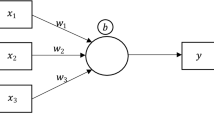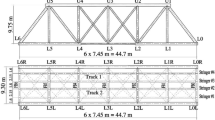Abstract
This paper presents a model-based method of damage detection and severity identification in structural elements. The model-based method is performed with a finite element model. One of the important challenges in damage identification problems is lack of measured degrees of freedom and limitations of installed sensors on the structures. The new approach of this study is the use of expanded mode shapes data to train artificial neural network (ANN). In this study, the measured mode shapes are expanded by SEREPa. SEREPa expansion is developed based on the System-Equivalent Reduction and Expansion Process (SEREP), which is a non-smooth method and protects the measured data. ANN was then trained through the expanded data as inputs, location and severity of damage as outputs. The algorithm used to train ANN is scaled conjugate gradient. The advantage of this algorithm is that less data storage space is used and lower computation costs are needed. To show SEREPa’s efficiency in estimating unmeasured mode shapes, an experimental example containing a truss tower was presented. Two numerical examples including a plane truss and a space truss were presented to illustrate efficiency of damage detection method. Finally, the proposed method was verified by an experimental example. Damage prediction results for both numerical and experimental examples indicated an acceptable accuracy of the proposed method.



















Similar content being viewed by others
References
Farshadi M, Esfandiari A, Vahedi M (2017) Structural model updating using incomplete transfer function and modal data. Struct Control Health Monit 24(7):1–13. https://doi.org/10.1002/stc.1932
Kaveh A, Dadras A (2018) Structural damage identification using an enhanced thermal exchange optimization algorithm. Eng Optim 50(3):430–451. https://doi.org/10.1080/0305215X.2017.1318872
Wei Z, Liu J, Lu Z (2018) Structural damage detection using improved particle swarm optimization. Inverse Probl Sci Eng 26(6):792–810. https://doi.org/10.1080/17415977.2017.1347168
Zare Hosseinzadeh A, Ghodrati Amiri G, Seyed Razzaghi SA (2017) Model-based identification of damage from sparse sensor measurements using Neumann series expansion. Inverse Probl Sci Eng 25(2):239–259. https://doi.org/10.1080/17415977.2016.1160393
Doebling SW, Farrar CR, Prime MB (1998) A summary review of vibration-based damage identification methods. Los Alamos National Laboratory, Massachusetts, USA, Rep. LA-UR-98-0375
Hakim SJS, Razak HA (2014) Modal parameters based structural damage detection using artificial neural networks–a review. Smart Struct Syst 14(2):159–189
Hosseini M, Khoshnoudian F, Esfandiari A (2017) Improved data expansion method used in damage detection method. J Civ Struct Health Monit 7(1):15–27. https://doi.org/10.1007/s13349-016-0205-4
Miguel LF, de Menezes RR, Miguel LFF (2006) Mode shape expansion from data-based system identification procedures. Mecanica Computacional 25:1593–1602
Ghannadi P, Kourehli SS (2018) Investigation of the accuracy of different finite element model reduction techniques. Struct Monit Maint 5(3):417–428. https://doi.org/10.12989/smm.2018.5.3.417
Kourehli SS (2015) Damage assessment in structures using incomplete modal data and artificial neural network. Int J Struct Stab Dyn. https://doi.org/10.1142/S0219455414500874
Dinh-Cong D, Vo-Duy T, Nguyen-Thoi T (2018) Damage assessment in truss structures with limited sensors using a two-stage method and model reduction. Appl Soft Comput 66:264–277. https://doi.org/10.1016/j.asoc.2018.02.028
Marwala T (2010) Finite element model updating using computational intelligence techniques: applications to structural dynamics. Springer, London. https://doi.org/10.1007/978-1-84996-323-7
Liu F, Li H (2012) Rapid direct-mode shape expansion for offshore jacket structures using a hybrid vector. Ocean Eng 51:119–128. https://doi.org/10.1016/j.oceaneng.2012.05.015
Gordan M, Razak HA, Ismail Z, Ghaedi K (2017) Recent developments in damage identification of structures using data mining. Latin Am J Solids Struct 14(13):2373–2401. https://doi.org/10.1590/1679-78254378
Hakim SJS, Razak HA (2013) Structural damage detection of steel bridge girder using artificial neural networks and finite element models. Steel Compos Struct 14(4):367–377
Nazari F, Baghalian S (2011) A new method for damage detection in symmetric beams using artificial neural network and finite element method. Int J Eng Appl Sci 3(2):30–36
Weinstein JC, Sanayei M, Brenner BR (2018) Bridge damage identification using artificial neural networks. J Bridge Eng. https://doi.org/10.1061/(ASCE)BE.1943-5592.0001302
Goh LD, Bakhary N, Rahman AA, Ahmad BH (2016) Application of neural network for prediction of unmeasured mode shape in damage detection. Adv Struct Eng 16(1):99–113. https://doi.org/10.1260/1369-4332.16.1.99
Kourehli SS (2018) Prediction of unmeasured mode shapes and structural damage detection using least squares support vector machine. Struct Monit Maint 5(3):379–390. https://doi.org/10.12989/smm.2018.5.3.379
Au FTK, Cheng YS, Tham LG, Bai ZZ (2003) Structural damage detection based on a micro-genetic algorithm using incomplete and noisy modal test data. J Sound Vib 259(5):1081–1094. https://doi.org/10.1006/jsvi.2002.5116
Ghiasi R, Ghasemi MR, Noori M (2018) Comparative studies of metamodeling and AI-based techniques in damage detection of structures. Adv Eng Softw 125:101–112. https://doi.org/10.1016/j.advengsoft.2018.02.006
Zhang Z, Sun C, Bridgelall R, Sun M (2018) Road profile reconstruction using connected vehicle responses and wavelet analysis. J Terrramech 80:21–30. https://doi.org/10.1016/j.jterra.2018.10.004
Zhang Z, Sun C, Bridgelall R, Sun M (2018) Application of a machine learning method to evaluate road roughness from connected vehicles. J Transp Eng Part B Pavements. https://doi.org/10.1061/JPEODX.0000074
O’Callahan J and Li P (1994) A non smoothing SEREP process for modal expansion. In: Proceedings of the 12th international modal analysis
Kaveh A, Zolghadr A (2015) An improved CSS for damage detection of truss structures using changes in natural frequencies and mode shapes. Adv Eng Softw 80:93–100. https://doi.org/10.1016/j.advengsoft.2014.09.010
Qu ZQ (2013) Model order reduction techniques with applications in finite element analysis. Springer, Berlin. https://doi.org/10.1007/978-1-4471-3827-3
Weber B, Paultre P (2009) Damage identification in a truss tower by regularized model updating. J Struct Eng 136(3):307–316. https://doi.org/10.1061/(ASCE)ST.1943-541X.0000105
Lyn Dee G, Bakhary N, Abdul Rahman A, Hisham Ahmad B (2011) A comparison of artificial neural network learning algorithms for vibration-based damage detection. Adv Mater Res 163:2756–2760. https://doi.org/10.4028/www.scientific.net/AMR.163-167.2756
Møller MF (1993) A scaled conjugate gradient algorithm for fast supervised learning. Neural Netw 6(4):525–533. https://doi.org/10.1016/S0893-6080(05)80056-5
Kaveh A, Bakhshpoori T, Hamze-Ziabari SM (2018) GMDH-based prediction of shear strength of FRP-RC beams with and without stirrups. Comput Concr 22(02):197–207. https://doi.org/10.12989/cac.2018.22.2.197
Beale MH, Hagan MT, Demuth HB (2012) Neural network toolbox™ user’s guide. Citeseer, Boston
MATLAB (2018). https://www.mathworks.com/help/matlab/
Kim MJ, Eun HC (2017) Identification of damage-expected members of truss structures using frequency response function. Adv Mech Eng 9(1):1–10. https://doi.org/10.1177/1687814016687911
Majumdar A, Maiti DK, Maity D (2012) Damage assessment of truss structures from changes in natural frequencies using ant colony optimization. Appl Math Comput 218(19):9759–9772. https://doi.org/10.1016/j.amc.2012.03.031
Los Alamos National Laboratory Engineering Institute (2018) SHM Data Sets and Software. http://www.lanl.gov/projects/national-security-education-center/engineering/software/shm-data-sets-and-software.php
Ha NV, Golinval JC (2010) Damage localization in linear-form structures based on sensitivity investigation for principal component analysis. J Sound Vib 329(21):4550–4566. https://doi.org/10.1016/j.jsv.2010.04.032
Hemez FM, Doebling SW (1999) Test-analysis correlation and finite element model updating for nonlinear transient dynamics. Los Alamos National Laboratory, Massachusetts, USA, Rep. LA-UR-98-4573. https://www.osti.gov/biblio/759471
Author information
Authors and Affiliations
Corresponding author
Additional information
Publisher's Note
Springer Nature remains neutral with regard to jurisdictional claims in published maps and institutional affiliations.
Rights and permissions
About this article
Cite this article
Ghannadi, P., Kourehli, S.S. Data-driven method of damage detection using sparse sensors installation by SEREPa. J Civil Struct Health Monit 9, 459–475 (2019). https://doi.org/10.1007/s13349-019-00345-8
Received:
Accepted:
Published:
Issue Date:
DOI: https://doi.org/10.1007/s13349-019-00345-8




